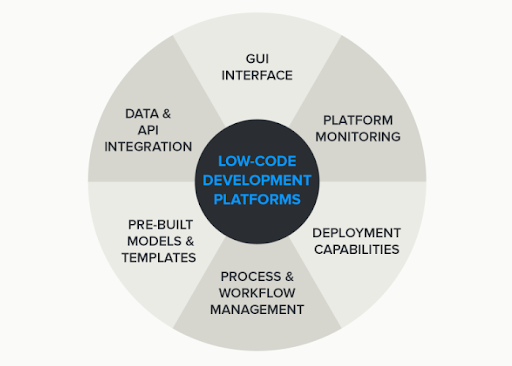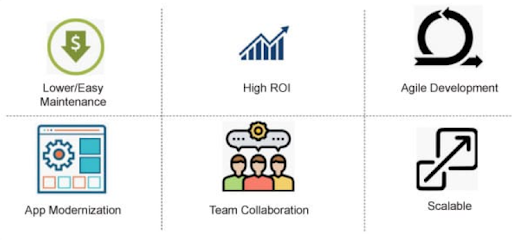Staying updated with modern trends is the new business imperative. You must have a reliable platform that slashes the app creation time for that. Developing applications is now more than merely a technical discipline; it has become an art form.
Applications have become common in the corporate sector. Although earlier separate, business and IT are exploring ways to collaborate to enhance their effectiveness. Nowadays, almost everyone uses advanced and sophisticated applications in their personal lives, whether ordering food or managing inventory for their business. There are about 7 million apps available, and a study suggests that app downloads will cross 200 billion by 2025. You can find a maximum number of companies with a website or an app that contributes to building their online presence. Nearly 62% of companies have apps, and half the small businesses have an app to connect with customers.
This article will give an insight into what the quantified Return on Investment of low-code platforms means for your business and ways to increase it.
What is the ROI of Low-Code?
It is essential to discern what and how low-code works before looking at the potential return it offers. Pro and free low-code platforms thrive as firms endeavor to simplify and automate their workflows while raising bars for an ideal customer experience. It is not here to replace skilled developers; it streamlines their workflows, alleviates the development process, and expedites app creation without compromising quality and standards.

How does low-code work? Is it as easy as many claims? Low-code application platforms enable non-professional developers to engineer apps and software. You might have dragged numbers between rows in Excel or cut and pasted text from one document to another, even if you are not a fan of programming. It is what you precisely do when developing apps on free low-code platforms. Employ its drag-and-drop features and interactive interfaces to fabricate a pleasant face for your brand. It begins with a simple drawing, literally! You work in a flowchart concept, specify your idea by clicking and configuring, and you will be all set! The fact that the low-code platform chops off the tedious and line-by-line coding are the cherry on top!
Looking at Low-Code ROI
Low code is something enterprise software firms are adopting for apparent reasons. Low-code platform in enterprise translates to measurable business value. It improves capabilities and helps ventures flourish. Low code for enterprise software can be effective and efficient and open the door to a scalable and reliable platform. You can access various positive ROI in several forms to drive merit results. For instance,
- Easy and simplified UI and UX development for browser and mobile applications
- Convenient collaboration with business users
- Support for process automation
- Rapid prototyping abilities
- On-premise and cloud availability
- Accelerate innovation and digital transformation
- Empowers customers to do more with the software
You can account for qualitative and quantitative data to measure the ROI of low-code platforms. While the former may include agility to adjust products to address changing customer demands and improved employee morale, quantitative data comprise cost savings, faster go-to-market times, and increased customer satisfaction. Various metrics like reducing IT backlog, expenditure, stress factors, and IT output demonstrate whether you are getting your money’s worth from the low-code development software.
6 Ways Low-code can increase ROI on Enterprise Software
Traditional app development methods for enterprise software are past and on their way out now. Low code has become a well-known platform that companies use. It is a practical move since it considerably reduces code and development time.
Configurability and transparency are fundamental for providing a better experience and raising the value of enterprise software. However, many overlook the key aspects that line them directly to achieve higher returns. There are six routes for attaining a higher Return on Investment (ROI).
1. Faster External Integrations
Many vendors assert that they utilize open Application Programming Interfaces (APIs) but face issues leveraging external systems. APIs are primarily for specific and pre-determined scenarios. The application internally communicates, for example- between the business logic and the user interface in a proprietary way that external systems can not leverage. You can utilize in-built features like validation, simulation, and proofing to aid in designing and deploying secure applications and integration with low-code platforms.
- A robust RESTful APIs-based architecture with Open API Initiative specifications allows customers to employ low-code for enterprise software to extend it on the outside and facilitate task-specific app development.
- You can orchestrate processes across multiple applications when using external low-code.
- Low code for enterprise software enables you to access whatever you do internally to the software and automate external tools.
2. Low-code approaches to Configuring and Automating Internal the software
Many use low code to define the internal working of software and give customers more control over their software. It facilitates the data model extension, user interface customization, and user navigation flow, enabling customers to design new screens and fields.

Low-code for enterprise software embeds IPA capability to enhance the platform’s working. It enables the software to:
- Capture required additional input from users as part of their existing business transactions.
- AI and machine learning models join hands to lay down what steps come next inside the automation or predict the values.
- Machine learning recommends automated and continuous improvement of processes and proactively makes alterations for stimulating outcomes.
Around 73% of CFOs admit they streamline their workflows and processes with integrations and automation. And 23% consider low code as the most critical investment for automation. Low-code platforms aim to furnish an intuitive, codeless way to automate process steps and user actions, besides adding machine learning capabilities to hear Intelligent Process Automation (IPA). It democratizes intelligent systems creation by making it accessible to business analysts and line managers.
3. Built from the Ground-up with Low-code
Low code with RESTful APIs simplifies the development and enhances the ROI of enterprise software. You can automate processes, access data, and create extensions to software on the outside via external and internal systems. Whether using external low-code or internal tools, you can access the correct part of the platform to process automation or support an integration.
- Low-code for enterprise software lets you modify without causing disruptions in existing systems, evolve the platform effortlessly, and supply it to customers so they can realize value.
- It assists in developing new functionality to frame high-quality solutions and industry-specific tools faster at a reasonable price.
- You can reflect more about how your software looks through the user interface and other systems powered by RESTful APIs using low-code for enterprise software.
Low-code Domain-Specific Language (DSL) can help you produce exceptional solutions that surpass the set standard. DSL describes the intent of what the elements of an application like API should do; instead of showing how it has to be done technically, making the process easier and faster. You can provide across web browsers and native apps on Android, Windows, and iOS using the same DLS as the one in the user interface.
4. Lower IT Expenditure
Software maintenance is in no way cheap. You will add new features and incorporate the latest tools to complement your growing business. However, IT Expenditure directly affects your ROI of low code. Low code does not demand high expenditures; you can begin with a small investment due to its lower development cost. A survey revealed that almost 70% of developers learned how to create applications within a month despite having zero background experience. A benefit of using low-code for enterprise software is meeting future requirements besides the present ones.
- Low code significantly cuts most or all the development, implementation, and maintenance expenses.
- It saves you from spending on hiring additional developers.
- You and your team can focus on core tasks and save time every month without writing or hiring someone to write code.
It is also the primary metric to calculate the ROI of your platform. The expenditure compares your planned IT budget against the current spending. You can identify the under-supplied areas of your infrastructure, map your resources, and prepare a budget to minimize overspending.
5. Quicker Digital Transformation
The world is turning digital, and a much-needed transformation has become a reality for several firms. About 56% of CEOs affirm that digital improvements have increased revenue. And a study reveals that a good 92% of SMEs believe digital transformation is crucial for their business. DX gives a hand in adapting to the current trends and seeking the goals you wish to acquire. Low code has slowly emerged as the core technology for digital transformation.
- You can create various apps like custom analytics dashboards and management software for a particular field and tailor code to extend the capabilities.
- Developers are the end-users of low-code platforms. They are ideal for tech-savvy programmers and newbie developers to work quickly.
6. Increased IT Output
Low-code development software delivers quality solutions to users in a short time. Citizen developers and business leaders can craft their applications without hiring any developer. It also enables your IT team to work on complex tasks that require a professional skill set. You can churn out apps that meet your needs and standards with Rapid Application Development (RAD) in low code.
- Low-code platforms create software, ensuring it is bug-free and up to the benchmark.
- Low code allows instant prototype designing and iterations, helping reduce the turnaround time for IT.
IT output is an objective way to measure the ROI. You can compare the time to resolve requests before and after low code implementation and analyze and assess its impact on your organization.
Low-code for Enterprise Software: The Way Forward
Creating apps may sound like a luxury and something out of your skillset, especially when enterprise applications appear unnecessarily complex. The limited availability of IT resources gives rise to low-code application platforms. Consequently, many organizations believe low code to be a wise investment, given its speed and cost.
No need to be sad if you are lacking in the technical department or skeptical about incorporating low code in your development process; it is alright! It is absolutely understandable, seeing how challenging it is to pick one platform among many options. Each is different and accompanies varied use cases, features, developer experience, targeted users, and pricing models. Hence, the ROI also differs based on multiple factors.
At Parangat, we shoulder the process to help you find the ideal platform that ticks off your requirements and falls right into your budget. You can consult with our experts to learn about several alternatives in the market and discover what suits you the best. Our services go far beyond advising and consultation. We design optimal and feasible mobile app development equipped with the latest features and technical stack to make your business visible digitally and outperform competitors.

With roll up sleeves, dive in and get the job done approach, it was in the year 2010 when Sahil started Parangat Technologies. Emphasizing a healthy work culture and technology-driven company, he has successfully created a workplace where people love to work and live. He is a software engineer and a passionate blockchain enthusiast.


 +44-7511-112566
+44-7511-112566 +353-1-8079571
+353-1-8079571 +1-415-799-9792
+1-415-799-9792

